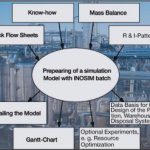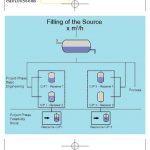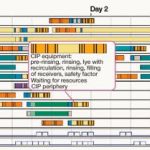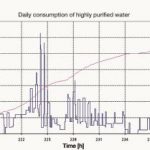The biotechnological active substance production places high demands on security and quality when planning and constructing production facilities, in particular for complex multi-product plants. The processes can be accompanied with the process simulation tool Inosim batch, a simulation application for batch-oriented processes and bulk-oriented procedures. The clear illustration of complex process dynamics with the help of the simulation tool is a safe foundation for further planning.
Annette Kaya
LSMW offers a complete range of services for the pharmaceutical, chemical and biotechnological industry. These encompass consulting, planning and the realization of projects to qualification and start-up of the facility. It is important to attain a high measure of planning security during a project as soon as possible. The simulation is therefore predominantly used in the early planning phases, e.g. for feasibility and concept studies and in basic engineering, in order to optimize the facility in good time. The use of the simulation is also feasible in detail engineering with a certain effort.
Basis of the simulation
The simulation model is prepared on the basis of various documents. Block flow sheets, mass balances as well as R&I patterns are all of importance. The system limits must be defined prior to the simulation, i.e. the level of model detail is determined. The detailing of the model is primarily dependent on the given data by which LSMW accomplishes the simulation according to a standardized procedure. The project phase is a further point of reference for detailing the model.
The objective of a feasibility study for example is the optimization of the equipment. The cleaning of the equipment, which is carried out in various rinsing steps, is compiled in only one step with regard to the required total time in this early planning phase. More accurate data, such as the required rinsing amounts for the respective equipment, are only determined in later project phases, the time requirement for cleaning the equipment is however not insignificant for the process. The accurate analysis of the required operating resources creates a reliable data basis for the safe design of the production, warehouse and disposal systems, if the simulation is then used in a later planning phase.
Design of the simulation model
The simulation model consists of equipment, basic formulations, order list, resources and various monitoring instruments. Each piece of equipment is only available once, as in the real facility, but can however be used several fold. The basic formulations define, which process steps require specific equipment for a defined period of time. The basic formulation corresponds to a process or a production regulation in the real-life facility, assigned to the partial facilities. Different levels of detail are defined according to requirements. The basic formulation information can be exported to Excel and thereby made accessible to all project participants. The configuration of the formulations complies with S88. The temporal sequence of the individual basic formulation is regulated in the order list.
Resources are aids, which can be necessary for accomplishing the process steps. CIP-facilities, personnel, valve nodes or also heat loads can be represented as resources. The simulator routine assigns these at the beginning of a process step and releases them at the end of the step. Resources can be available in an unlimited quantity or have a limited capacity as in real life operation. Waiting periods can result during the simulation, if resources are limited and cannot be made available at the necessary point in time.
CIP-facility example
The CIP-facility is an application option for a limited resource. The total equipment assigned to the CIP-facility is assumed to be a CIP-resource. The individual rinsing steps run over this resource, i.e. the resource is assigned at the beginning of the first rinsing step (= CIP-facility) and released after the final rinsing step. No other piece of equipment requiring this resource can clean during the occupied time, parallel procedures are thereby avoided. Equipment waiting for a resource is entered into a waiting list. This is then processed chronologically after the resource has been released. The activity period of the CIP-facility is recorded during the simulation period. This allows determination and optimization of the extent of utilization of the CIP-facility.
It is important in later project phases to define the size of the individual CIP-requirements as accurately as possible. The present simulation model is now supplemented by the receiving vessels, which can also be networked. The receiving vessels controller can be illustrated in the simulation model by a dynamic fill level controller. This coordinates the filling of the receiving vessels, if the required fill level is not attained and simultaneously prevents a shortfall of the critical minimum fill level. Parallel processes can be excluded here too, by linking the receiving vessels to the CIP-resource.
The formulation module represents a new possibility of testing the most differing scenarios. Repeatedly occurring series of process steps are developed once as a formulation module and then reused several times in basic part-formulations. Certain process steps, such as cleaning or sterilization procedures are filed centrally here. The sequence, duration or number of process steps for different scenarios can be centrally modified in the formulation module; the best operational sequence is determined without a large effort. A lot of time can be saved during process optimization due to the low modeling effort when illustrating different process scenarios.
Simulation results
The simulation takes place after implementing all model components. The simulation procedure intends to confirm the feasibility and functionality of the facility; possible problem areas can be revealed and optimized. The facility can be virtually operated for days, months or even years. But a simulation run takes only few minutes. The actual formulation design is visualized and examined with the help of the batch flow diagram. Inosim Plan creates a graphic interactive Gantt diagram at the end of each simulation run. The time is represented on the x-axis and the equipment with the individual process steps on the y-axis. Recurring process steps – for example CIP – are always highlighted in the same color to improve overview. Selected areas can also be regarded separately due the possibility of creating different views. Bottlenecks are made visible in the Gantt diagram. A solution for the bottleneck can be found by simulating various experiments. Each experiment can be compared with the original operational sequence since previous process data is still available.
Worst case priniple
The evaluation of facility data is a constantly recurring challenge for the facility constructor after taking the decision for the best experiment. The design of the production, warehousing and disposal systems, which are used at the same time or overlaid by different process steps, can hardly be analytically assessed, the systems are therefore frequently designed according to the worst case principle. The simulation accomplishes a concurrence analysis for each medium and is a good basis for the system definitions. A substantially better approximation to the real life process is the calculated total consumption, maximum consumption and average medium consumption, which is calculated for each medium using the simulation run. The peak value of the medium is further optimized using the received data; the limitation of water withdrawal to one process consumer for example prevents simultaneous withdrawal by different process consumers, avoiding overlaps minimizes the maximum consumption. This limitation is examined in a new simulation run to avoid possible process bottlenecks. Producer data can then be calculated from the recorded data, which can then be represented, examined and manifested in further detailing of the model. The capacity analysis for the equipment used in each model informs on the extent of utilization of the individual part-facilities, the busy time for the utilized resources are also transferred to Excel.
LSMW uses the clear representation of complex process dynamics, enabled by the simulation tool, as planning fundamentals. The visualization of the batch affiliation in the Gantt diagram enables optimization of resources, media and apparatus utilization; bottlenecks are highlighted.
cpp 464
More information on the service provider
Literature – Starting a Business in the Life Sciences
Achema 2006
Share:










